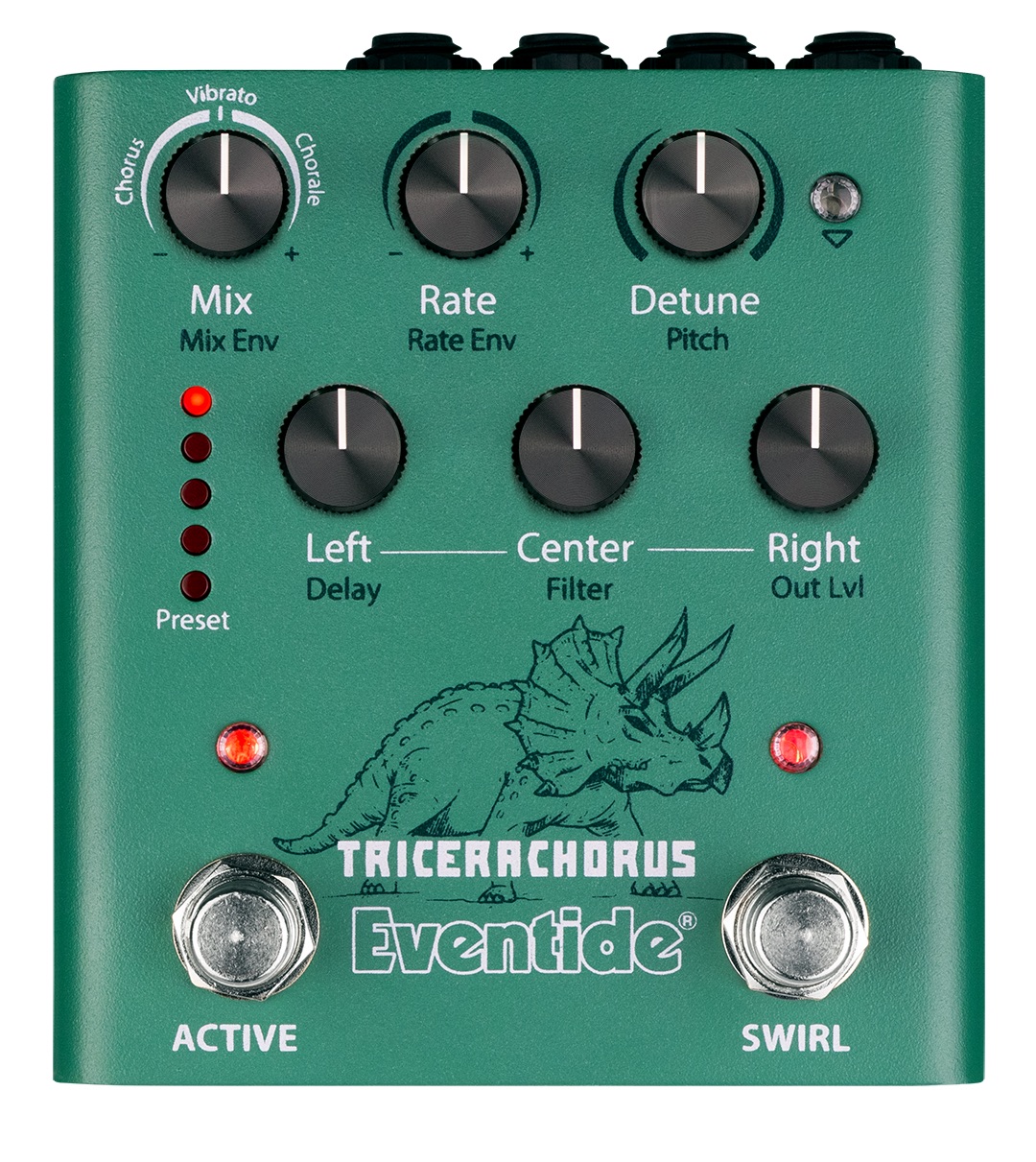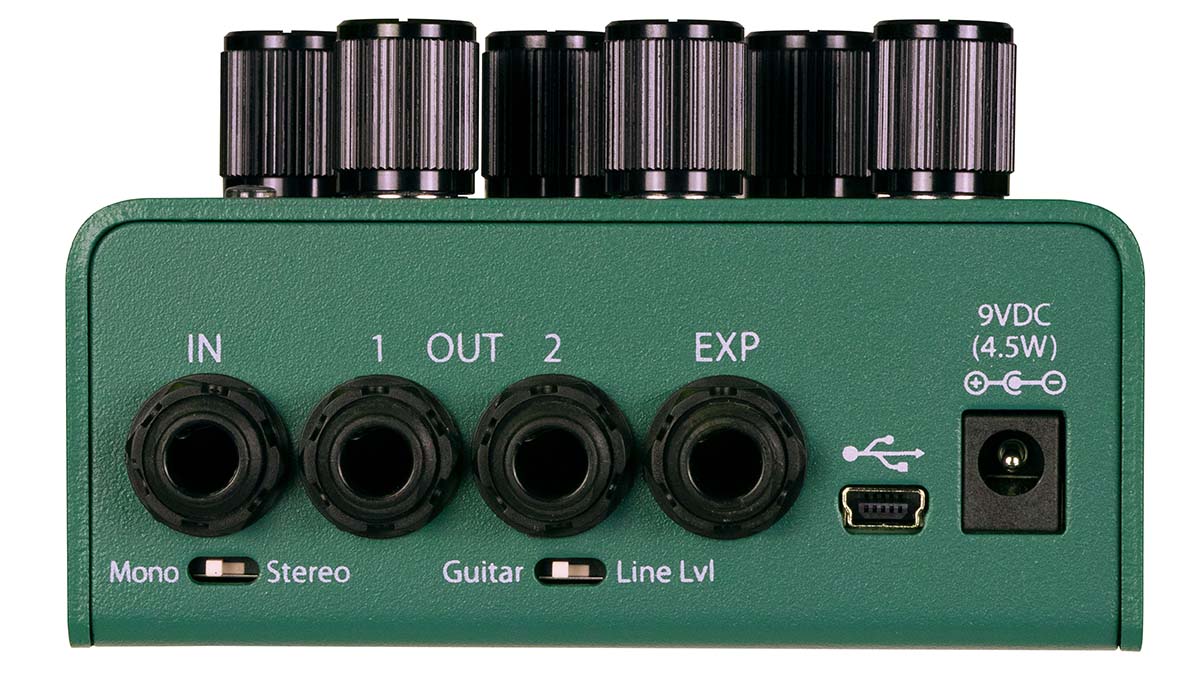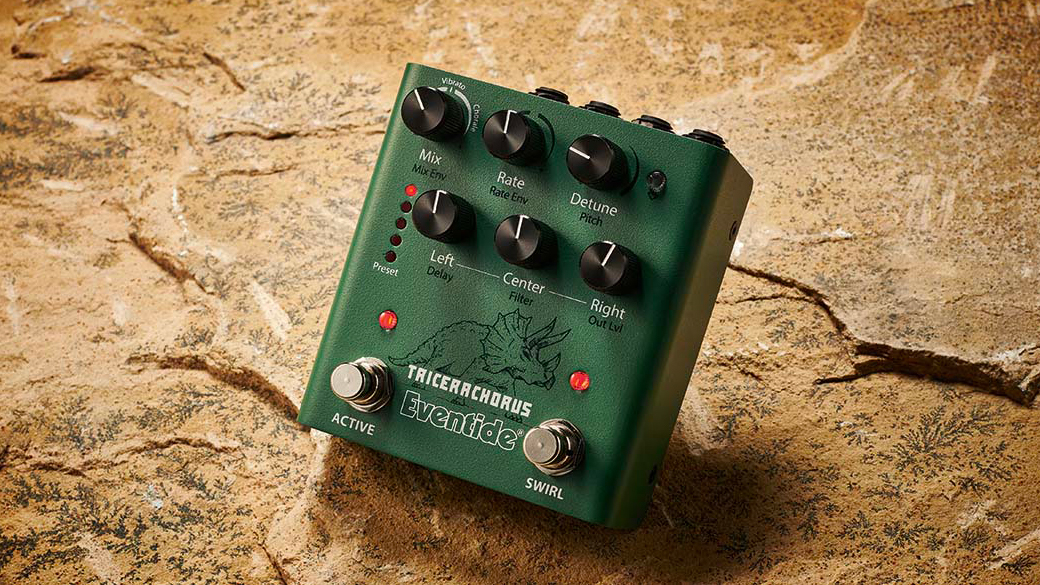Guitar World Verdict
Eventide’s TriceraChorus delivers quite possibly the most comprehensive array of deep and dreamy modulation effects we’ve seen in a single relatively compact pedal.
Pros
- +
Variety of modulation effects.
- +
Mono or stereo.
- +
Computer-based editor.
- +
Expression pedal input.
- +
Switchable Swirl effect.
Cons
- -
Moving between primary and secondary parameters takes getting used to.
You can trust Guitar World
Now roaming the Earth is the latest in Eventide’s dot9 series pedal range: the TriceraChorus. Maybe there’s a hint of irony in the name and dinosaur logo as some may consider chorus an extinct effect that had its time back in the ’80s… but if anyone can drag it into modern times, Eventide is the company to do so.
The TriceraChorus pedal takes its inspiration from chorus effects of the 1970s and early ’80s but particularly the rackmounted Dytronics CS-5 Tri-Stereo Chorus, which was the workhorse of LA studio musicians such as Steve Lukather and Michael Landau.
This vintage unit featured three simultaneous bucket brigade delay lines (Left, Center and Right) to create rich and lush chorusing, and the TriceraChorus takes this approach as well with its three independent chorus voices. Besides these, though, the pedal also features Eventide’s MicroPitch detuning and a Swirl footswitch, which brings phasing into the mix.

The TriceraChorus can take a mono or stereo input and has a stereo output for the full spatial effect, although it can still function perfectly effectively with a mono output.
There are five instantly available presets you can call up with its footswitches (denoted by the five-LED preset ladder), but you have access to 127 presets if you use MIDI or connect the pedal up to a computer running the Eventide Device Manager (EDM) software, an easy-to-use graphic editor and librarian for preset storage. An array of six front-panel knobs adjusts a dozen parameters: six primary and six secondary.
Sounds
Three knobs in a row in the centre of the pedal adjust the modulation depth of the Left, Center and Right voices, but before going there a Mix knob lets you choose the type of chorusing you’re going to get. To its left is the Chorus effect, and from fully anti-clockwise you can add in the effect from a fully dry position.
This is based on the sort of sound you’d get from vintage chorus pedals; we found a classic Boss CE sound between 10 and 11 o’clock. You reach 100 per cent wet at the central position of the knob and, hence, the pedal’s Vibrato sound.
Clockwise from there you get all of the wet/dry variations of the Chorale effect, which is the pedal’s emulation of the more complex chorusing of the rackmount units. A separate knob controls the overall modulation rate, although that can also be controlled by an external tap switch or MIDI Clock.
The last of the main parameters on the front panel is Detune, which adds increasing amounts of the stereo MicroPitch detuning (detuning pitch is the secondary parameter of the same knob).
MicroPitch is actually independent of the Chorus/Chorale Mix so can be used as an effect in its own right if your Mix is set to dry sound. It’s a valuable asset, whether just used for subtle thickening or sweetening, or as a component in dialling in realistic rotary speaker effects.
There’s further tweaking in the secondary set of parameters, with delay of up to 200ms to add ambience, very effective low- and high-cut tone control via the Filter parameter, plus envelope adjustment of Mix and/or Rate via playing dynamics to create some interesting effects such as the rate rising as a chord dies out.

There are so many sonic variations here that it’s easy to lose track, but exploring the 65 factory presets in the EDM provides a masterclass in how the parameters work together. This is a truly classy-sounding pedal with all fully adjustable shades of chorus plus vibrato, flanger and rotary stylings.
With a real sense of dimension and movement, it offers a lovely wash of enriched sound with as much warble and pulse as you need. That’s even before bringing in the Swirl effect, which adds its phasey layer over proceedings – a soft haziness that can transform the sound so it’s like a second effect.
For performance, you can set the main footswitch to be latching or momentary, and an expression pedal can be assigned to adjust multiple parameters. Alternatively, you can use the EXP input for footswitches for tap tempo or preset changes.
Verdict
No simple two-knob chorus pedal (although one of those is still a prime contender if basic chorus is all you need), Eventide’s TriceraChorus is a pedal that can serve up those basics but go way, way beyond them.
Specs
- PRICE: $299 / £279
- ORIGIN: China
- TYPE: Chorus pedal
- FEATURES: Multiple Bypass options (Buffered, Relay, DSP+FX or Kill dry), latching or momentary footswitch action, 5 onboard presets, 127 total presets, software editing
- CONTROLS: Mix/Mix Env, Rate/Rate Env, Detune/Pitch, Left/Delay, Center/Filter, Right/Output Level, Shift button, footswitch latching/momentary button, preset save button, Mono/Stereo switch, Guitar/Line level switch, Active footswitch, Swirl footswitch
- CONNECTIONS: Standard input, standard outputs 1 & 2, EXP, USB
- POWER: Supplied 9V DC adaptor 200mA
- DIMENSIONS: 100 (w) x 115 (d) x 58mm (h)
- CONTACT: Eventide Audio
Trevor Curwen has played guitar for several decades – he's also mimed it on the UK's Top of the Pops. Much of his working life, though, has been spent behind the mixing desk, during which time he has built up a solid collection of the guitars, amps and pedals needed to cover just about any studio session. He writes pedal reviews for Guitarist and has contributed to Total Guitar, MusicRadar and Future Music among others.













